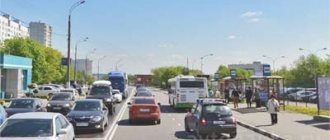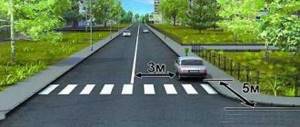The distance between stops, according to SNiP (SP) and GOST standards, depends on the category of the road along which the route was laid. In cities, stopping points are closer than in rural areas or on federal highways. After reading the article, you will learn what the minimum distance between bus stops in populated areas should be according to the standards.
In the metropolis
Classification of highways by category
The distance between two public transport stops is affected by road congestion. The degree of congestion and the category of the road are determined according to GOST P 52398-2005.
Passenger boarding
Below we present a combined table from the regulatory document.
| Category | Number of lanes (both directions) | Width of one lane (m) | Center separator | Workload (vehicles per day) |
| 1 | from 4 | 3,75 | Required | from 14 000 |
| 2 | from 2 to 4 | 3,5–3,75 | Not required | from 6000 |
| 3 | 2 | 3,5 | Not needed | from 2000 to 6000 |
| 4 | 2 | 3 | Not needed | from 200 to 2000 |
| 5 | 1 | from 4.5 | Not needed | up to 200 |
Long-distance buses run on roads of categories 1–3. Public transport connects settlements located at great distances. The final stop is the bus station located in the city. Intermediate visits to cities and villages are allowed to arrange transfers. As a rule, such visits are short-term.
Roads of categories 4–5 are located in cities and towns.
Local buses, trams, and trolleybuses run along them. Routes can be winding or circular. Several bus stops on different routes may be located close to each other.
Distance between stopping points on the roads
The distance from stop to stop is established by OST 218.1.002-2003, SNiP 2.07.01-89 and SP 42.13330.2016. The standards established by OST between bus stops for roads of different categories are shown in the table below.
| Category | Minimum distance (m) | Maximum distance (m) | Curve radius (m) |
| 1–3 | 3000 (in densely populated areas – 1500) | 5000 | 1–2: 1000 3: 600 |
| 4–5 | Not limited | 600 | 400 |
The SNiP and SP listed above establish additional restrictions on the location of stops in cities and towns. We will consider these limitations in the corresponding section of the article.
Other standards for the location of stops
Stopping points are located on a piece of land with a slope of no more than 20% horizontally and 40% vertically. Pavilions cannot be placed:
- in places with poor visibility of the road;
- in areas with an accident rate of up to 0.7;
- in areas with a traffic safety factor of up to 20;
- in places where the height of the embankment is up to 150 cm;
- in lowlands: possible flooding of the area, formation of snow drifts.
Public transport operation
The stopping point must be located no closer than 250 meters to the railway crossing. It is allowed to combine a waiting area and a car parking area, as well as a bus parking area. Then parking is located behind the pavilion.
Distance between stops in the city according to standards and GOST
On roads of categories 1–3, stops in opposite directions are located strictly opposite each other. The two stopping points are separated by a pedestrian crossing. There is no provision for shifting between stops. This solution is convenient for both passengers and drivers of cars moving along the highway.
Not far from the road
In cities, stops in opposite directions are allowed only with an offset. The distance between waiting areas on opposite sides of the road must be at least 30 meters.
When two buses arrive at the same time, they do not create a traffic jam and do not block the view for pedestrians and drivers. This distance between stations must be maintained strictly according to standards.
Within the city, bus stops should be located at a distance from:
- Entry to the territory of a block or microdistrict: up to 20 m.
- Nearest pedestrian crossing across the road: up to 500 m.
- Publicly visited objects (shopping centers, cinemas, museums, etc.): up to 250 m.
- Educational institutions (schools, colleges, universities, etc.): up to 500 m.
- Clinics, hospitals and other medical institutions: up to 150 m.
- Entry to the territory of the garage cooperative: up to 30 m.
- Passage points in the industrial zone: no more than 600 m (in medium and small cities - no more than 800 m).
- The main entrance to the park, public recreation or sports area: no more than 800 m.
What are the fines?
Warning triangle
A driver who violated the rules in the area covered by a road sign indicating the location of the bus stop and was caught by traffic police officers will be forced to pay a fine of approximately one thousand rubles, clause 3.1 of Art. 12.19 Code of Administrative Offences. If this offense took place in Moscow, St. Petersburg and their regions, the fine is tripled (clause 6).
evacuate to impound lot
Important nuances
Drivers often manage to avoid spending money. This happens if there are no signs or road markings at the intended stop site. Then the drivers indicate to the traffic police inspectors that this actual stop of the route transport is not marked in any way, which means that they did not violate the rules and there is no reason to apply administrative punishment to them in the form of fines.
Most often there are no signs at the parking area for the following reasons:
- the stop is new and they have not yet been installed;
- They were dismantled and replacements have not yet been installed.
Any of these reasons may exempt the driver from administrative penalties.
Entering into a debate with the inspector and having unquestioning arguments of their innocence, car owners often convince him not to issue a fine. But if the traffic police representative still stands his ground, then it is enough to record a video or take a photo of the place of the alleged violation
It is important that the finished material shows that the stop is not marked with either a sign or markings. When it comes to court proceedings, the judge will in any case take the driver’s side, since he acted within the framework of the law and traffic rules
Categories
- Car insurance
- Driver's license
- Road accident
- Traffic rules, Violations and fines
- Registration with the traffic police
- Miscellaneous
- News
What is the distance between public transport stops in the city according to GOST
The standards adopted in Russia are the same for all cities, be it Moscow, St. Petersburg, Novosibirsk, Krasnoyarsk, Volgograd, Orenburg, Voronezh, Samara or Saratov. The locations for the installation of stops are chosen by the local administration.
Glass and metal option
At the same time, the standard must be observed: the distance in the city between public transport stops should be 400–600 meters. This is a requirement of GOST and SNiP (SP). This standard applies to tram, trolleybus and bus stops in the city.
Bus routes have been built
They will be required to disembark passengers only where there are stops and set fares after their approval with the authorities, depending on the flight. For violations, they will face fines of up to 20 thousand rubles.
This is provided for by the new federal law on the regulation of passenger transportation by road and ground urban electric transport, which came into force last Tuesday. The text of the law is published by Rossiyskaya Gazeta.
Before this, there was no single document in Russia that would regulate the relations between authorities and operators, and the purpose of the law is to establish such relations. Essentially, an important gap that has been expected since 2012 has been filled. And it has appeared only now because serious transport reform has begun in Moscow, where they are switching to a more transparent and efficient work scheme.
“A similar model of relations is used in all developed countries, and the new law meets the requirements that will improve the quality of services provided by carriers,” says Alexander Ryzhkov, an expert at the Institute of Transport Economics and Transport Policy at the National Research University Higher School of Economics.
This law divided transportation into two types: interregional (long-distance) and intermunicipal. In the first case, operators themselves declare their desire to introduce a flight, and fares are not regulated there. In the second, a strict regime is introduced, when the initiative comes from local authorities. The choice of how to organize transport links will be very wide, and a circle of specialists familiar with all regulatory models will help make it.
The old system, according to which buses traveling from one region to another could make stops wherever the driver asks, will also change. From now on, the carrier can only drop off at bus terminals and bus stations, but if they are not on the route, then they will be allowed to deviate from the rules.
Legislative changes also affected drivers of public urban transport. If they let someone off a bus, trolleybus or tram in an unspecified place, they will be fined 3 thousand rubles, and if they violate it again - 5 thousand. Parking public transport outside a station or depot will cost 5 thousand rubles, and the company itself can be fined 20 thousand.
Municipal flights, that is, those that do not go beyond the city limits, will be determined by local authorities. Here they have the final say in tariff policy. Almost the same work scheme is being introduced in Moscow, St. Petersburg and Sevastopol. Considering that these are federal cities, regional authorities became responsible for intermunicipal routes.
To introduce or change the route of trolleybuses, trams or buses that carry the population not only within the city, but also through the regions, the desire of companies alone will not be enough. They will receive voting rights through an open competition.
“The federal law provided some framework, but it is very loose,” continues Alexander Ryzhkov. In his opinion, the regulatory mechanism could be improved in the future. For example, change the criteria for determining the winning operator of an open competition with unregulated tariffs. The list contains a provision on work experience, but this does not matter for the passenger, since he does not know the operator by sight, and for competition such evaluation criteria are unsuccessful, since the arrival of new carriers is difficult.
As for municipal routes, in one of the options, tariffs are set by regional authorities. If the right to form them were transferred to municipalities that make payments for transportation, it would be more logical, concludes RG’s interlocutor.
Arrangement and design of a stopping point
The stopping complex includes the following elements:
- zones for accelerating and braking vehicles;
- pocket for parked vehicles;
- waiting area or covered pavilion;
- adjacent part of the sidewalk;
- trash can or container;
- pedestrian crossing with or without traffic lights;
- lighting system (road lights);
- rainwater drainage system;
- information stands or signs with transport schedules.
Typical option
The width of the pocket for a bus or trolleybus to enter is equal to the width of the other lanes. The length of the waiting area depends on the number of vehicles that can stop at the same time. If one route stops: 10 meters, two - 25 meters, three or more - 35 meters.
Pavement height
The height of the waiting area above the road level: at least 20 cm. The roadway must be separated from the waiting area by a curb. The pavilion cannot be placed closer than 3 meters to the roadway.
Improvement
A public toilet must be located no closer than 15 meters to the pavilion. The lights should illuminate not only the waiting area, but also 100 meters of the roadway in both directions. Distance from the bike path to the pavilion: up to 150 cm. Width of the pedestrian path leading to the site: 75 cm.
Arrangement of a pedestrian crossing for children
Interactive boards
Bus stops in Moscow and other large cities are sometimes equipped with interactive displays. The display shows how much time is left until the desired route arrives. The value is reset when city transport leaves the stopping point.
Design
A trolleybus stop in a populated area is designed in the same way as a bus stop. It must have a pavilion with a bench and a trash can, information signs or an interactive display.
The design of stopping points is not limited by standards.
Components of stops
- Stop sign. In the simplest case, the stop can only be equipped with a sign;
- Full house containing route numbers and timetables;
- Stop pocket - for bus and trolleybus stops. Represents the expansion of the roadway necessary to ensure that a stopped bus or trolleybus does not interfere with other vehicles;
- Stop platform - for more comfortable boarding and disembarking of passengers. For low-floor buses and trolleybuses, the height of the curb at a stop usually coincides with the height of the step, so that the curb can be considered the simplest platform;
- Stop pavilion - to protect passengers from adverse weather conditions. Usually equipped with seats. Pavilions of high-speed public transport are often equipped with ASCP turnstiles, which allows passengers to pay for travel before boarding, thereby significantly increasing the speed of boarding and disembarking.
Stop sign where to stopSign 2.5 Driving without stopping is prohibited
Sometimes, especially in rural areas, bus stops are just small “houses” with a missing wall on the bus stop side.









